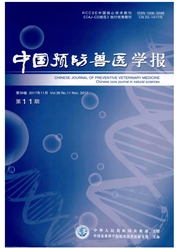

 中文摘要:
中文摘要:
为了探究高致病性猪蓝耳病病毒(HP-PRRSV)的遗传变异特征,本研究对GenBank中235株HP—PRRSV GP5序列的遗传进化、主要氨基酸基序、抗原性以及N-糖基化位点数量和位置的变异进行了分析。结果表明HP-PRRSV之间的同源性较高,与其他参考毒株相比,这些病毒处于一个相对独立的分支中,而且与经典疫苗株的亲缘关系较远。这有助于解释经典疫苗株对于HP—PRRSV为何起不到理想的免疫保护效果。在病毒的中和表位序列中存在着规律的点突变,同时抗原性比较显示HP-PRRSV与经典毒株之间存在着一定的差异。绝大多数的HP-PRRSV的N-糖基化位点在数量上多一个,而且位置要向羧基端平移2个氨基酸,从而使得中和表位两侧直接与糖链相连,可能会造成中和表位被糖侧链所遮掩,本研究由此推测减弱中和抗体对HP-PRRSV的有效识别,促进病毒逃避机体体液免疫。
 英文摘要:
英文摘要:
A highly pathogenic porcine reproductive and respiratory syndrome (HP-PRRSV) was emerged in China since the summer of 2006. In order to investigate the genetic diversity of HP-PRRSV, we analyzed 235 GP5 sequences of HP-PRRSVs deposited in GenBank and compared with those of homologous amino acid neutralizing among themselves, but genetically distinct classical from the strains. The results showed that the HP-PRRSVs were highly vaccine strains which were derivated from classical mutation occurred in the prime neutralizing epitope and an additional N-glyscan chain was found close epitope. It was proposed that this N-glyscan chain could contribute to the viral immunological escape PRRSVs. An to the prime from humoral immunity.
 同期刊论文项目
同期刊论文项目
 同项目期刊论文
同项目期刊论文
 期刊信息
期刊信息
